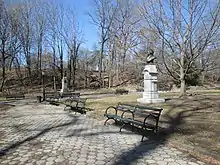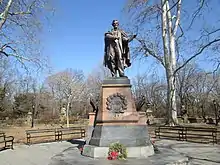Concert Grove
The Concert Grove is a section of Prospect Park, Brooklyn, New York City, that historically functioned as an outdoor music venue. It still serves as a sculpture garden lined with busts of composers, largely put up by German American and Irish American singing societies. The Concert Grove also includes the Concert Grove Pavilion, formerly known as the Oriental Pavilion, and adjoins a Lincoln sculpture facing the lake.

History and design
The Concert Grove is located on the northeast edge of the Prospect Park Lake.[1] Originally designed in 1847,[2] it was laid out so park patrons could hear music being played on the later-demolished Music Island.[3] However, as the area was considered to have had bad acoustics, concerts were moved to the nearby Music Pagoda in the Nethermead section of Prospect Park when that structure opened in 1887.[4] The Concert Grove served as the "artistic center" for Prospect Park, and in the 19th century, hosted German choral groups.[5] The southern part of the Concert Grove was later modified to make way for an ice skating rink called Wollman Rink,[3] which was approved in 1960[6] and opened the following year on the site of the Music Island.[7] The grove was renovated in the 2010s,[8] and the Music Island restored,[9] with the demolition of the rink and the construction of the LeFrak Center, a year-round sports facility.[8]
The grove's style complements that of the Central Park Mall; however, unlike the elongated, rectangular Mall, the Concert Grove was laid out radially, in order to blend more smoothly with the landscape. It consists of two pathways fanning outward, away from the lake, as well as a pedestrian walkway running through the middle of the grove. Two curved terraces, paralleling the shoreline and running perpendicularly to the spokes of the "fan", divide the grove into plateaus.[3] A path runs southward from the Concert Grove to the LeFrak Center.[10]
Structures
Pavilion

The Concert Grove Pavilion, also known as the Oriental Pavilion, is located in the middle of the Concert Grove, measuring 40 by 80 feet (12 by 24 m) with a roof and columns in a Middle Eastern or Indian style.[3][11] The pavilion is supported by eight columns made of cast iron.[3]
Formerly a table service restaurant, it was converted to a snack bar in the 1950s after the closure of the Concert Grove House. The pavilion was damaged in a 1974 fire and was restored in 1987,[12] though restoration work was temporarily halted after a contractor died on site.[13] The pavilion has since deteriorated, though plans to restore the pavilion were revealed in 2015.[2][12] It has been very occasionally used for events in recent years, such as Shakespeare performances,[14] as well as for weddings.[15]
Statues

The grove is used as a sculpture garden, and as such, is lined with numerous busts.[4] Some of the more prevalent busts are those of classical composers and lyricists by German American (some won at national Sängerfests) and Irish American local singing societies.[11][4] The busts, include those of Ludwig van Beethoven (erected 1894),[16] Wolfgang Amadeus Mozart (1897),[17] Carl Maria von Weber (1909),[18] and Edvard Grieg (1914).[19]
A statue of Abraham Lincoln, the first Lincoln monument in the United States,[8] is also located at the Concert Grove. Sculpted by Henry Kirke Brown in 1869, it was initially located at Grand Army Plaza. The Lincoln statue was relocated to the Concert Grove in 1896, and restored in the late 1980s.[20] Another restoration of the Lincoln statue took place in 1998.[21] From 1959 until the early 2010s the statue faced the rear fence of the Kate Wollman Skating Rink. Following the Concert Grove restoration and closure of the rink it now faces the edge of the Prospect Park Lake. It was proposed to move the statue back to its original position as part of the restoration,[8] but as of 2016, it was still located in the Concert Grove.[22] There is also a bust of Washington Irving just across East Drive from the Concert Grove.[23] The grove includes a bust of poet Thomas Moore as well.[4][24]
Former structures
A frame chalet called the Concert Grove House was located north of the grove.[4] It was completed in 1873[25] and contained a similar design to The Dairy, a now-demolished stone cottage, though the Concert Grove House was a frame building.[3] The Concert Grove House served as a restaurant before being demolished in 1949.[3][13][4] Restrooms were also provided within the building.[3]
References
- Prospect Park Alliance Map (PDF) (Map). Prospect Park Alliance. 2018. Retrieved October 22, 2019.
- "Prospect Park Concert Grove". NYCgo.com. Retrieved October 22, 2019.
- Lancaster, Clay (1972). Prospect Park Handbook (2nd ed.). New York: Long Island University Press. ISBN 978-0-913252-06-2.
- "Concert Grove History". Prospect Park Alliance. 2008. Archived from the original on March 23, 2009. Retrieved March 21, 2009.
- Gonzalez, David (June 14, 2005). "Monuments and Memories, for a Moving Experience". The New York Times. ISSN 0362-4331. Retrieved October 22, 2019.
- "Prospect Park Rink Approved; Wollman Fund Gives $300,000". The New York Times. October 7, 1960. ISSN 0362-4331. Retrieved February 7, 2019.
- "New Wollman Rink Is Dedicated in Brooklyn". The New York Times. December 23, 1961. ISSN 0362-4331. Retrieved February 16, 2019.
- Newman, Barry (December 10, 2011). "In Brooklyn, G Marks the Spot for a Bust of Abe Lincoln". The Wall Street Journal. Retrieved October 22, 2019.
- Pollak, Michael (August 7, 2011). "Monitoring Progress of Wollman Rink in Prospect Park". The New York Times. ISSN 0362-4331. Retrieved February 16, 2019.
- Kimmelman, Michael (October 20, 2013). "Restoring Brooklyn's Pastoral Heart". The New York Times. ISSN 0362-4331. Retrieved October 22, 2019.
- Scherer, Jenna (August 10, 2017). "15 hidden gems of Prospect Park". Curbed NY. Retrieved October 22, 2019.
- "Group Plans to Renovate Long-Neglected Areas of Prospect Park". The New York Times. August 5, 2015. ISSN 0362-4331. Retrieved October 22, 2019.
- "Changing Scene". New York Daily News. January 25, 1987. p. 236. Retrieved October 21, 2019 – via newspapers.com
 .
. - "WEEKENDER GUIDE". The New York Times. June 17, 1988. Retrieved October 22, 2019.
- See, for instance:
- "WEDDING/CELEBRATIONS; Erin Tobin, Roger Bearden". The New York Times. April 20, 2003. ISSN 0362-4331. Retrieved October 22, 2019.
- "Darcey Steinke, Michael Hudson". The New York Times. June 20, 2009. ISSN 0362-4331. Retrieved October 22, 2019.
- "Prospect Park Monuments – Ludwig Van Beethoven". www.nycgovparks.org. New York City Department of Parks and Recreation. Retrieved October 22, 2019.
- "Prospect Park Monuments – Mozart Memorial". New York City Department of Parks and Recreation. Retrieved October 22, 2019.
- "Prospect Park Monuments – Von Weber Memorial". New York City Department of Parks and Recreation. Retrieved October 22, 2019.
- "Prospect Park Monuments – Edvard Grieg Memorial". New York City Department of Parks and Recreation. Retrieved October 22, 2019.
- "Abraham Lincoln". New York City Department of Parks and Recreation. June 26, 1939. Retrieved October 22, 2019.
- Lewine, Edward (August 2, 1998). "NEIGHBORHOOD REPORT: PROSPECT PARK; New Effort Keeps Lincoln and Friends Looking Their Best". The New York Times. ISSN 0362-4331. Retrieved October 22, 2019.
- "Emancipation desecration! Prospect Park's historic Lincoln statue vandalized". Brooklyn Paper. November 25, 2016. Retrieved August 21, 2019.
- "Prospect Park Monuments – Washington Irving Memorial". New York City Department of Parks and Recreation. Retrieved October 21, 2019.
- "Thomas Moore Memorial". New York City Department of Parks and Recreation. Retrieved October 22, 2019.
- "The Park". Brooklyn Daily Eagle. November 22, 1872. p. 4. Retrieved October 17, 2019 – via Brooklyn Public Library; newspapers.com
 .
.